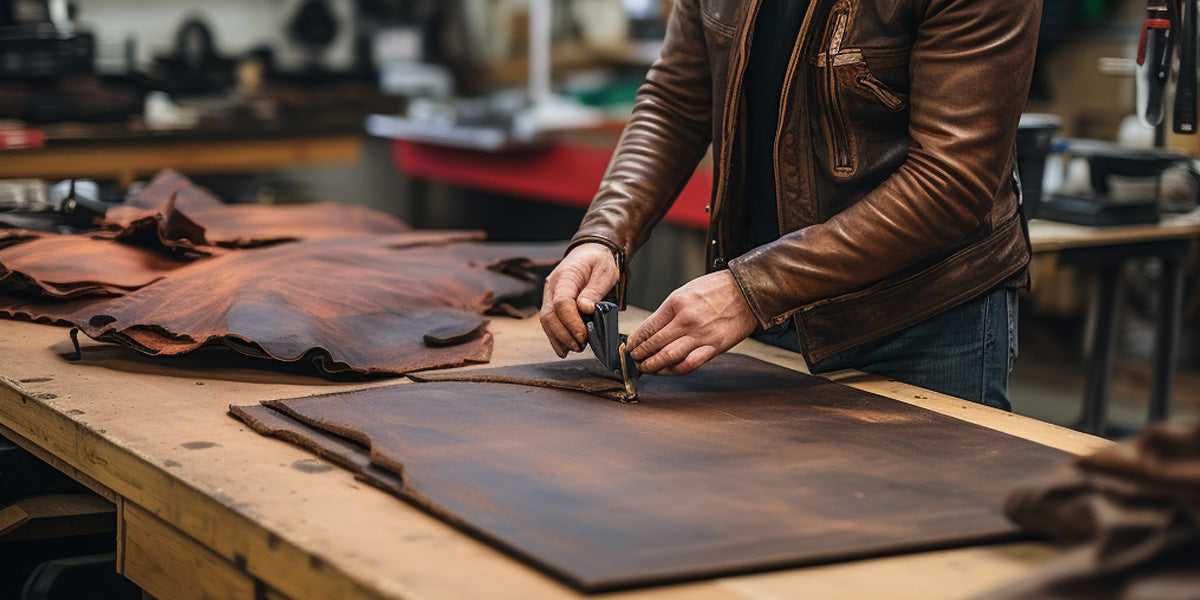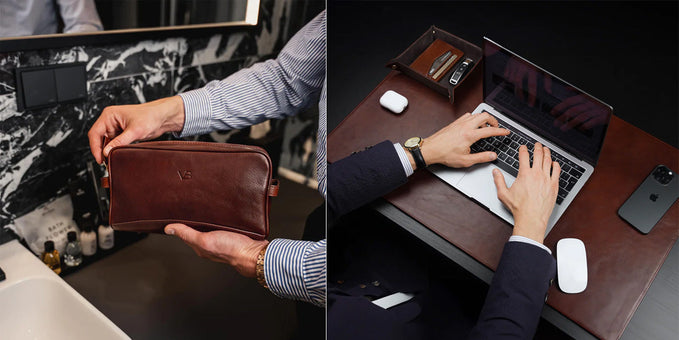Chrome Tanned Leather Guide: Pros & Cons vs Vegetable Tanning

Chrome-tanned leather is a popular material used to create car interiors, leather shoes, bags, and furniture.
In this guide to chrome tanned leather, we’ll look at the advantages and disadvantages; so you can make a more informed decision when shopping for leather goods.
What is Chrome-Tanned Leather?

Chrome-tanned leather is a soft, yet strong fabric made from chromium sulphate-treated animal skins.
It is quick and inexpensive to produce, softer than vegetable-tanned leather and is the only leather to retain its color for its entire lifespan.
But it comes with a list of cons.
Chrome tanning leather uses chemicals, creates toxic wastewater, and in third-world countries where production is unregulated, it has a detrimental effect on the environment - this is why at Von Baer, we only use vegetable-tanned leather in our products.
It doesn’t last as long as vegetable-tanned leather and cheaper products can carry a chemical smell.
While chrome-tanned leather produced in Europe and the United States is slightly more regulated and environmentally friendly than that made in developing countries such as Bangladesh and India, we certainly cannot consider it a ‘green’ material.
Here, we delve into the world of chrome-tanned leather, covering how it is made, its most popular uses, and why it comes with such a bad rap.
| Attribute | Vegetable-Tanned Leather | Chrome-Tanned Leather |
|---|---|---|
| Tanning Process | Uses natural tannins from plant sources, such as tree barks and fruits. | Treated with chromium salts to tan the hides. |
| Environmental Impact | Generally more environmentally friendly as it uses natural tannins. | Can have a higher environmental impact due to the chemicals involved in the chrome tanning process. |
| Color | Develops a warm, natural patina and darkens with age. | Usually retains its original color without significant patina development. |
| Flexibility | Less flexible initially, but becomes more supple over time with proper care and use. | More flexible and softer from the beginning. |
| Water Resistance | Less water-resistant compared to chrome-tanned leather. | More water-resistant and resistant to stretching. |
| Absorption | Can absorb water and oils, leading to potential stains. | Less absorbent, making it more stain-resistant. |
| Texture and Feel | Firmer and has a natural, earthy scent. | Softer and can have a slightly chemical smell from the tanning process. |
| Uses | Commonly used in high-quality leather goods like belts, saddles, and luxury items. | Widely used for garments, shoes, handbags, and upholstery. |
Chrome Tanned Leather: The Manufacturing Process

Chrome tanning remains the most common tanning process used in leather industries worldwide.
It not only preserves the animal skin and prevents rotting, but it also creates a more supple and pliable material for manufacturing clothes, shoes, furniture, car seats, luggage, and handbags.
Step 1: Preparing the Hides
- Unlike vegetable tanning techniques, which take months to complete, chrome tanning (or chromium tanning) starts in the tannery area of the slaughterhouse immediately after the slaughter.
- After being removed from the carcass, the hide goes through a machine to remove any remaining flesh and hair before the first tanning process gives it a distinctive blue tinge.
Step 2: Receiving 'Wet Blue' Hides
- Professional chrome tanners typically receive the hides in this state, often referred to as ‘wet blue’, from hide dealers, who form a crucial part of the leather industry.
- Hide dealers work with slaughterhouses worldwide to help chrome tanners receive the hides they need and play a vital role in the leather industry, both here in the US and overseas.
Step 3: Grading and Cutting
- After receiving the hides, often by the truckload, a chrome tanner will grade each piece according to size, weight, and quality.
- Next, they will have the hides cut to the required thickness using a band-knife splitter, with the upper part typically used to make grain leather products and the lower part to make suede.
Chrome Tanned Leather Quality

Introduced many years ago, chrome tanning is a quick and easy process that creates a more versatile and water-resistant leather than vegetable tanning.
Chrome-tanned leather is also stain and heat-resistant, and if produced correctly, it can last many years without showing signs of wear and tear.
Sadly, much of the chrome-tanned leather produced in developing countries does not last as long as it should.
Manufacturers often cut corners by using a low-cost acrylic varnish to seal the edges, which can quickly result in cracks, and focus more on quantity than quality.
What Does Chrome Tanned Leather Look Like?

One of the benefits of chrome-tanned leather is that we can dye it in almost any color, and it will retain that color for the duration of its lifespan.
Chrome-tanned leather doesn’t fade or develop a patina, so it is well-suited to high-fashion items, but it is not a fabric that improves with age.
Leather fans will notice that chrome-tanned leather does not have the natural scent of vegetable-tanned leather, with many hides taking on a chemical-type smell that rarely goes away.
What is Chrome Tanned Leather Used For?
Manufacturers typically use chrome-tanned leather to make jackets, backpacks, handbags, upholstered furniture, car seats, and smaller accessories such as gloves.
Essentially, this type of leather is suitable for any product that does not require structural stability.
What Are the Pros of Chrome Tanned Leather?
Chrome-tanned leather may not be as environmentally friendly as we would like, but it does come with a long list of benefits.
Here we look at the benefits of chrome-tanned leather and why many manufacturers and designers choose this fabric over any other:
Water Resistance
- Unlike vegetable-tanned leather, chrome-tanned leather is highly water-resistant and ideal for making boots, shoes, luggage, leather jackets, motorcycle seats, bags, and any other item subjected to wet weather conditions.
- During the tanning process, chrome salts create a protective layer on the surface, which is why chromed leather can easily withstand limited exposure to water.
Stain Resistance
- With improved water resistance comes better stain resistance, and it is unlikely that you will find water spots on chrome-tanned leather, although the material will stain with oils.
Heat Resistance
- Chrome-tanned leather is also heat-resistant to a certain degree, so heat damage is less of a concern with this type of leather.
- As a result, manufacturers can use the hot creasing technique to create unique shapes and neat arches in chromed leather, which is difficult to achieve with vegetable-tanned alternatives.
Low Maintenance
- Chrome-tanned leather requires less maintenance than natural leather and suede, so you won’t need to clean and condition it as often.
- Wiping it with a microfiber cloth after rain exposure should be all you need to keep it looking its best, although shoes and boots may need extra TLC in areas where the foot flexes to prevent cracking.
High Tensile Strength
- Contrary to popular belief, chrome-tanned leather has a high tensile strength far superior to vegetable-tanned leather.
- It stretches well with the right tools and takes a lot of pressure for this material to reach breaking point.
Softness
- Softness is one of the main advantages of chrome-tanned leather. You’ll notice how soft it is the minute you touch it.
- Unlike vegetable-tanned leather, which softens as it ages, chrome-tanned leather is soft from day one, and with regular care and attention, it will stay that way for many years to come.
- For this reason, many manufacturers prefer to use chrome-tanned leather to make luxuriously soft wallets, purses, laptop bags, and jackets.
Color Possibilities
- You can dye chrome-tanned leather in almost any color, and it takes on bright colors exceptionally well.
- Unlike natural leather products, chrome-tanned leather products do not lose color over time, do not fade, and are unlikely to darken with age.
- For brightly colored leather belts, bags, smartphone accessories, and luggage, chrome-tanned leather is the obvious choice.
- You can dye it every color of the rainbow, then some, and enjoy its vibrant hue for years.
- On the flip side, natural colors tend to look less ‘natural’ on this kind of leather due to its protective coating, but if you are looking for an organic leather product, chrome-tanned leather would not be your first choice.
- Ultimately, it is all down to personal taste.
It Doesn’t Age
- Chrome-tanned leather doesn’t age like natural leather and doesn’t develop a patina over time.
- If you love the look of aged leather, a chrome-tanned leather handbag might not be the best investment, but if you want your bag to retain its richly pigmented look for life, chrome-tanned leather is the way to go.
What Are the Disadvantages of Chrome Tanning Leather?
Now we have looked at the advantages of chrome-tanned leather, we should cover the disadvantages of this type of material.
Not Environmentally Friendly

Unfortunately, the chrome-tanning process harms the environment, particularly in developing countries where a lack of regulation allows manufacturers to dispose of toxic wastewater irresponsibly.
If it is allowed to seep into the ground, the toxic wastewater produced during the chrome-tanning process can contaminate soil and groundwater supplies, and this is one of the main reasons why chrome-tanned leather gets a bad rap.
Products made in Europe and here in the United States are more regulated than those made in Bangladesh, China, and India, so always read the label when shopping for products made from chrome-tanned hide, and where possible, choose those manufactured close to home.
Does Not Last As Long As Vegetable Tanned Leather
Chrome-tanned leather products do not last as long as vegetable-tanned leather alternatives, and they do not age as well.
Over time, bags, clothing, and furniture made from this material will lose their shiny new appearance, so you could consider them more fast-fashion than an investment.
Cannot Be Tooled or Stamped After Tanning
You cannot tool, stamp, or pattern chrome-tanned leather, so brands cannot leave their mark on goods made from this kind of leather unless they do so before the start of the chrome tanning process.
Caring for Chrome Tanned Leather
Unlike natural leather products, chrome-tanned leather doesn’t require regular cleaning and conditioning to keep it looking its best, but you should apply wax now and again to maximize its water resistance.
Most shoe waxes are suitable for chrome-tanned leather shoes and boots but check the label before use.
Chrome-tanned leather does not like oil of any kind and applying it could clog the pores of your leather products and leave them dull, so avoid it at all costs.
Store chrome-tanned leather as you would natural leather; in a dry spot away from direct sunlight.
Related articles:
- Leather
- Faux leather
- Vegan leather
- Bonded vs Real vs Faux leather
- Bonded leather
- Genuine leather
- Pleather
- Top grain leather
- Leather guide for beginners
- What is leather patina
- Vegetable tanned leather
- Leather tanning
Chrome Tanned Leather vs Vegetable Tanned Leather

Both chrome-tanned leather and vegetable-tanned leather go through a tanning process, but the methods are very different.
To create vegetable-tanned leather, tanners use organic dyes and plant-based materials, rather than chemicals, to color the hide, so there are less color options. The process takes longer, too, with some vegetable-tanned leather taking months to complete. The result is a stiffer material that will develop a beautiful patina over time.
Vegetable-tanned leather typically has a sweet scent, while chrome-tanned leather has a more chemical smell.
You can see the natural fibers in veg-tanned leather, something you won’t see in the chrome-tanned alternatives, but this makes it more susceptible to fading and discoloration when exposed to the elements.
Vegetable-tanned leather is better for the environment, as it doesn’t require harsh, polluting chemicals.
Is Chrome Tanned Leather More Durable Than Vegetable Tanned Leather?
Chrome tanned leather and vegetable tanned leather are similar in terms of durability.
However, chrome-tanned leather is more water resistant, so better on items that are going to get wet more often.
How Do You Distinguish Chrome Tanned Leather from Vegetable Tanned Leather?
The most obvious way to determine if leather is chrome or vegetable-tanned is the smell, as chrome-tanning creates a chemical scent, whereas vegetable-tanning retains a natural leather smell.
The next easiest way to tell if a piece of leather is chrome-tanned or vegetable-tanned is to use boiling water.
- Take a heat-proof bowl, fill it with boiling water, and add a strip of leather.
- If it shrinks, shrivels, or twists within seconds of coming into contact with the boiling water, you can be confident that it is vegetable-tanned leather.
The reason is that chrome-tanned leather doesn’t react to boiling water. It may distort slightly, but due to its chemical composition, it will not curl up or shrink.
Conclusion
We hope you enjoyed our article on chrome tanned leather.
If you have any questions or comments, contact us at info@vonbaer.com, or leave them in the comments.
Want to read more? Check out our Leather pages.
Related articles:
- What is artificial leather?
- What is full grain leather
- Where does leather come from
- Mushroom leather
- Napa leather
- Pebbled leather
- Leather grades
- How is leather made
- Suede
- PU leather
- Bonded leather vs Faux leather
- Italian leather
- How to tell if leather is real
- Buffalo leather
- Suede vs Leather
- What is Real Leather
- Pu Leather vs Faux Leather
- Alternative Leather

Author: Albert Varkki
Albert Varkki is the co-founder of Von Baer. He understands leather products as a consumer, supplier, and a manufacturer, helping you with the inside knowledge you need, to choose the perfect leather product for you.
We strive for the highest editorial standards, and to only publish accurate information on our website.
Leave a Comment
Your email address will not be published.






